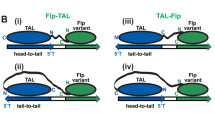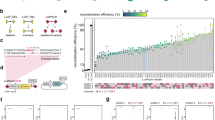Abstract
The FLP recombinase of the yeast 2 micron circle plasmid belongs to theInt family of recombinases. Only three amino acid residues are invariant among members of this family. Functional analyses of FLP protein variants mutated at these three residues suggest their involvement at specific steps of the recombination pathway. We propose that these residues play the same functional role in the mechanism of action of all theInt family recombinases.
Similar content being viewed by others
References
Andrews B J, Beatty L G and Sadowski P D 1987 Isolation of intermediates in the binding of the FLP recombinase of the yeast plasmid 2-micron circle to its target sequence.J. Mol. Biol. 193: 345–357
Andrews B J, Protean G A, Beatty L G and Sadowski P D 1985 The FLP recombinase of the 2μm circle DNA of yeast: interaction with its target sequences.Cell 40: 795–803
Argos P, Landy A, Abremski K, Egan J B, Haggard-Ljunquist E, Hoess R H, Kahn M L, Kalionis B, Narayana S V L, Pierson L S III, Steinberg N and Leong J M 1986 The integrase family of site-specific recombinases: Regional similarities and global diversity.EMBO J. 5: 433–440
Austin S, Ziese M and Sternberg N 1983 A novel role for site-specific recombination in maintenance of bacterial replicons.Cell 25: 729–736
Campbell A 1983 Bacteriophage λ. InMobile genetic elements (ed.) J A Shapiro (New York: Academic Press) pp. 65–103
Fried M and Crothers D M 1981 Equilibria and kinetics oflac repressor-operator interactions by polyacrylamide gel electrophoresis.Nucleic Acids Res. 9: 6505–6525
Gronostajski R M and Sadowski P D 1985 TheFLP recombinase of theSaccharomyces cerevisiae 2λm plasmid attaches covalently to DNA via a phosphotyrosyl linkage.Cell Biol. 5: 3274–3279
Heistand-Nauer R and Iida S 1983 Sequence of the site-specific recombinase genecin and of its substrates serving in the inversion of the C segment of bacteriophage Pl.EMBO J. 2: 1733–1740
Jayaram M 1985 Two-micrometer circle site-specific recombination: The minimal substrate and the possible role of flanking sequences.Proc. Natl. Acad. Sci. USA 82: 5875–5879
Kostriken R M, Morita C and Heffron F 1981 The transposon Tn encodes a site-specific recombination system: Identification of essential sequences, genes and the actual site of recombination.Proc. Nutl. Acad. Sci USA 78: 4041–4045
Plasterk R H A and van de Putte P 1984 Genetic switches by DNA inversions in prokaryotes.Biochim. Biophys. Acta 782: 111–119
Prasad P V, Horensky D. Young L-J and Jayaram M 1986 Substrate recognition by the 2 micron circle site-specific recombinase.Mol. Cell Biol. 6: 4329–4334
Prasad P V, Young L-J and Jayaram M 1987 Mutations in the 2λm circle site-specific recombinase that abolish recombination without affecting substrate recognitionProc. Natl. Acad. Sci. USA 84: 2189–2193
Reed R R 1981 Resolution of cointegrates between transposons gamma-delta and Tn defines the recombination site.Proc. Natl. Acad. Sci. USA 78: 3428–3432
Reynolds A E, Murray A W and Szotak J W 1987 Roles of the 2λm gene products in stable maintenance of the 2λm plasmid ofSaccharomyces cerevisiae.Mol. Cell Biol. 7: 3566–3573
Sadowski P D 1986 Site-specific recombinases: Changing partners and doing the twist.J. Bacteriol. 165: 341–347
Silverman M and Simon M 1983 Phase variation and related systems. InMobile genetic elements (ed.) J A Shapiro (New York: Academic Press) pp. 537–557
Tonegawa S, Sakano H, Maki R, Trauneckcr A, Heinrich G, Roeder W and Kurosawa Y 1980 Somatic reorganization of immunoglobulin genes during lymphocyte differentiation.Cold Spring Harbor Symp. Quant. Biol. 45: 839–858
Utatsu I, Sakamoto S, Imura T and Toh-E A 1987 Yeast plasmids resembling 2λm DNA: Regional similarities and diversities at the molecular level.J. Bacterial. 169: 5537–5545
Volkert F C and Broach J R 1986 Site-specific recombination promotes plasmid amplification in yeast.Cell 46: 541–550
Weisberg R A and Landy A 1983 Site-specific recombination in phage lambda. InLambda II (eds) R W Hendrix, J R Roberts, F W Stahl and R A Weisberg (Cold Spring Harbor, NY: Cold Spring Harbor Laboratory) pp. 211–250
Author information
Authors and Affiliations
Rights and permissions
About this article
Cite this article
Jayaram, M. TheInt family of site-specific recombinases: Some thoughts on a general reaction mechanism. J. Genet. 67, 29–36 (1988). https://doi.org/10.1007/BF02927735
Received:
Issue Date:
DOI: https://doi.org/10.1007/BF02927735




